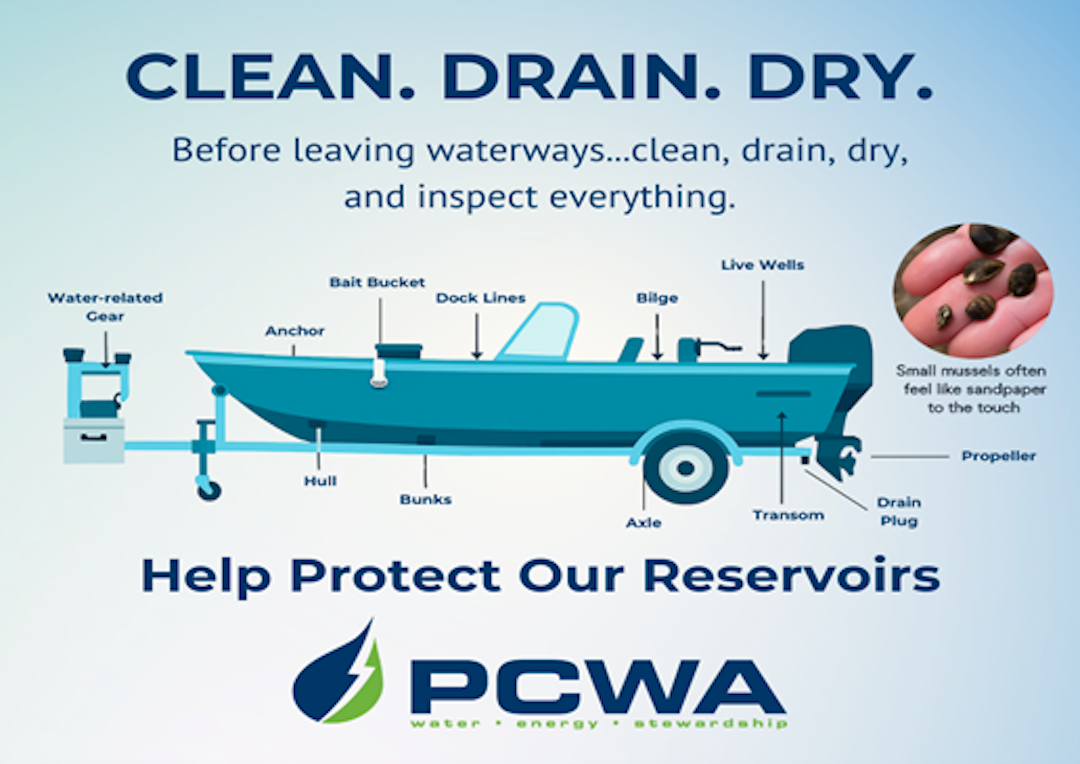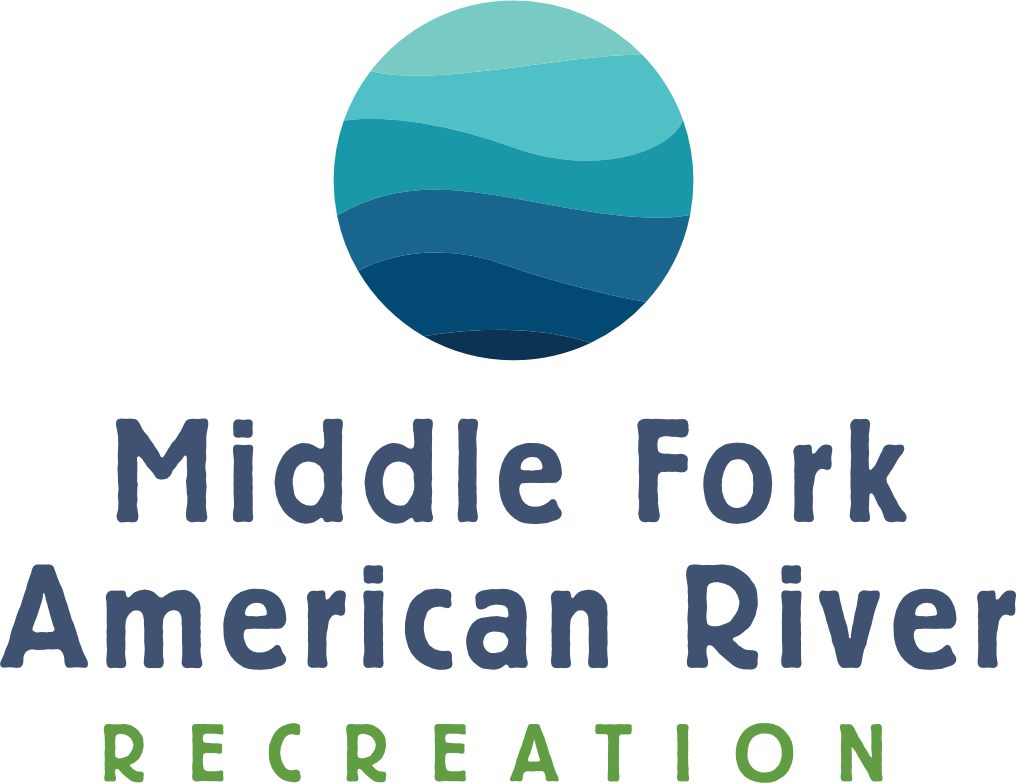
Aquatic Invasive Species
THE MFP RESERVOIRS ARE OPEN FOR RECREATION
PCWA reservoirs remain open for recreation, but protecting local waters from Aquatic Invasive Species (AIS) is a top priority. We are actively monitoring and implementing prevention measures to ensure long-term reservoir health. At this time, boat tagging and quarantine are NOT required. However, boaters must follow Clean, Drain, Dry protocols before launching. Prevention is a shared responsibility—your actions help keep our reservoirs safe, functional, and open for recreation.Aquatic Invasive Species (AIS)
Aquatic invasive species (AIS) are non-native plants, animals, and other organisms that primarily live in water. These species can spread quickly, disrupting ecosystems, damaging infrastructure, and threatening water quality.
AIS include:
- Plants: Algae, floating, submerged, and emergent plants
- Animals: Insects, fish, reptiles, mollusks, crustaceans, and amphibians
- Pathogens: Disease-causing organisms such as molds, fungi, bacteria, and viruses
Detailed AIS information is available from Invasive Species Info.
Invasive Mollusks: An Emerging Threat
PCWA reservoirs, including those in the Middle Fork Project (MFP), remain free of invasive mollusks, but vigilance is essential. The California Department of Fish and Wildlife (CDFW) has identified Quagga Mussels, Zebra Mussels, and New Zealand Mudsnails (NZMS) as serious threats to California's waterways. These species, along with Golden Mussels, have been detected in various states. Golden Mussels were recently found in the California Delta.
Golden Mussels, like Quagga and Zebra Mussels, can rapidly spread and are nearly impossible to remove once established. They clog infrastructure, disrupt water delivery and hydropower operations, and alternative ecosystems. Preventing their introduction is the only effective protection.
Protecting Our Reservoirs
Golden Mussels pose a serious threat to local waters, including French Meadows and Hell Hole Reservoirs. These reservoirs aren’t just scenic recreation spots — they provide clean drinking water, hydropower, and critical fire support for our communities. Preventing the spread of invasive species is essential to keeping them safe, functional, and open to recreation.
PCWA's Commitment to Monitoring & Prevention
PCWA is actively monitoring our reservoirs and collaborating with State and federal agencies, including CDFW and the Bureau of Reclamation (BOR). We conduct regular water quality testing and invasive species monitoring to stay ahead of potential threats. We’ve installed signage at all boat launches and facilities with clear instructions for boaters to follow Clean, Drain, Dry protocols before entering PCWA reservoirs. While we do not currently require boat tagging or quarantine, access and prevention measures may evolve based on regional risks. Increased boat traffic or confirmed infestations in nearby waterways could lead to additional protective actions.
Boaters play a vital role in stopping the spread. Keeping our reservoirs safe and open requires everyone to pitch in. Together, we can keep our reservoirs clean, safe, and accessible for all.
How You Can Help: Clean, Drain, Dry

Before launching in any PCWA reservoir:
✅ Clean off all visible mud, plants, and animals from your vessel and trailer.
✅ Drain bilges, live wells, motors, and any other areas holding water.
✅ Dry all parts of your boat and allow at least 5 full days of drying in warm, dry weather.
Other Resources
https://wildlife.ca.gov/Conservation/Invasives/Species/Golden-Mussel
https://dbw.parks.ca.gov/?page_id=28996
More about Invasive Mollusks
Invasive mollusks, including Quagga Mussel, Zebra Mussel, Golden Mussel, and New Zealand Mudsnail (NZMS) are not native to the United States but have been detected in various states, including California. If established, these species can rapidly spread, fowling boats and equipment, clogging water intakes, and hindering hydropower and water supply operations. In addition, these invasive AIS consume large quantities of microscopic plants and animals, which disturbs the natural ecosystem, harming native plants and wildlife.
Golden Mussel
(Limnoperna fortunei)
In October 2024, Golden Mussel was discovered in the Sacramento-San Joaquin Delta. This discovery is the first known occurrence of Golden Mussels in North America.
Golden Mussels are similar in appearance and biology to Quagga and Zebra Mussels. Golden Mussels are typically under 1.5 inches in length with a light golden to darker yellowish-brown to brown color shell. Golden Mussels are freshwater or brackish water species that are typically found firmly attached to hard/semi-hard surfaces in shallow (less than approximately 33 feet) water.
Golden Mussels pose a significant immediate threat to the natural ecosystems, water conveyance systems, infrastructure, and water quality in California and across the U.S. Therefore, the CDFW is closely monitoring golden mussel reports and is actively establishing management measures at popular boating reservoirs to reduce the potential for infestation.
Quagga Mussel
(Dreissena rostriformis bugensis)
Quagga Mussels are small (up to approximately 1 ½ inches) with a striped black and yellow patterned shell. Quagga Mussels can inhabit freshwater lakes, reservoirs and streams and colonize both soft and hard substrates. A single female can produce over a million eggs a year. The closest known occurrences of Quagga Mussel to the MFP are in Lake Mead and the Colorado River downstream of Lake Mead, as well as all watersheds receiving water via the Colorado Aqueduct System.
Zebra Mussel
(Dreissena polymorpha)

(Photo source: http://watrnews.com/2012/07/zebra-mussels-found-in-lake-ray-roberts/)
A Zebra Mussel is a small (up to about 2 inches) freshwater mollusk, with a yellow and brown zebra-patterned shell. Zebra Mussels can inhabit freshwater lakes, reservoirs and streams and colonize any stable substrate. A single female can lay 40,000 eggs in a single reproductive cycle and up to one million in a spawning season. The closest known occurrence of Zebra Mussels to the MFP is at San Justo Reservoir, in San Benito County, about 230 miles from the MFP. The Department of Water Resources has placed San Justo Reservoir under quarantine, banning recreational boating at the reservoir.
New Zealand Mudsnail
(Potamopyrgus antipodarum)

(Photo source: http://www.seagrant.umn.edu/newsletter/2006/06/images/mudsnail.jpg)
NZMS are tiny (less than ¼ inch) aquatic snails that can inhabit freshwater and brackish lakes, reservoirs and streams. The NZMS has an elongated, right-handed coiling shell, which varies in color from gray to light or dark brown. This species releases live young rather than eggs.
NZMS has been detected in various locations throughout California, including the Owens, Klamath, Russian, Lower American, Stanislaus, Merced, San Joaquin, and Sacramento rivers, and many of their tributaries. In February 2016, NZMS were discovered in the lower Yuba and lower Feather rivers. More recently, NZMS were detected on the South Fork American River near Bridal Veil Falls, the south shore of Lake Tahoe, 0.5 miles from the mouth of the Upper Truckee River, the Tahoe Keys area of Lake Tahoe, and the Truckee River.
The impact of NZMS infestations is not yet fully understood, but ecological impacts likely result in a decline in the abundance of native snails and benthic macroinvertebrate species important to local fisheries and other aquatic species. Similar to related economic impacts of invasive mussels, biofouling of water conveyance systems could occur with large NZMS infestations, albeit on a smaller scale than that of mussel infestations.




